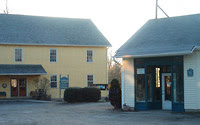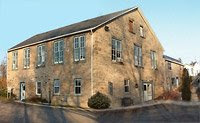William’s Mill is comprised of a Yellow Mill Building and a Stone Building. The buildings are reminiscent of the era in which th
 ey were built, and recall a time when a community was largely dependent upon mill operations. Today, the Mill’s architecture has been thoughtfully restored with the design remaining true to the buildings’ original purpose.
ey were built, and recall a time when a community was largely dependent upon mill operations. Today, the Mill’s architecture has been thoughtfully restored with the design remaining true to the buildings’ original purpose. The Mill buildings have been the center of Glen Williams for over 150 years and represent a vital part of the local area’s history. In fact, members of almost every family who lived in the Glen worked at this site at one time or another.
or another.
To fully appreciate the charm of the Mill, let’s wander back to its early days to discover exactly how it became the artist’s community it is today …
Built in the 1850s by the original founding family of Glen Williams called the Williams family, the Yellow Mill Building housed a sawmill that in its prime was capable of producing 14,000 feet of lumber per day. The frame is constructed of 12’ by 12’ timbers while the second floor is supported by steel rods from a wind beam, to enable a clear span on the main floor for maneuvering lumber and logs. At the back of the lower level of the mill, stonework remnants jut out from the wall in what is believed to have been the support for a water wheel axle.
A forest fire damaged the Yellow Mill Building in 1866. It was rebuilt and became a woolen mill in the early 1900s. In 1988, the building was restored and received a heritage designation under Ontario’s Heritage Act. The charred beams that remain in the weaving studio are a reminder of the fire and the Halton County Atlas shows in an illustration that the Yellow Mill originally looked similar to how it looks today. 
As flour was also necessary in the community, Charles Williams built a flourmill at the spot where the stone building now stands. Operating day and night, the flourmill was a busy place -- even producing flour for export to foreign markets.
It was however, destroyed by fire in 1890. Eight years later The Stone Building was converted into an electric power plant. Built from the foundations of the stone mill, the plant operated with water brought in through a penstock and dropped about six feet to a raceway beneath the basement floor. The power plant supplied power to Georgetown and Glen Williams. Although the lights were turned off at 11PM, it is said the power plant superintendent could be bribed with a bottle of “a pure beverage” to keep the lights on past 11. By 1911, the Hydro Electric Power Commission had been created and Glen Williams voted to join the Niagara power grid, ending the need for a local power plant.
In 1935 The Mill property was purchased by the Apple Products Company, which operated an apple-processing factory here until as recently as the 1980s.
Purchased by local entrepreneurs Doug and Mary-Lou Brock in 1985, the buildings underwent restoration. By 1989 parts of the building were usable and subsequently rented to a technological company. As more of the buildings became usable, the company assumed more space until 1994 when they moved out of The Mill entirely due to greater space needs.
The Mill then stood empty for the first time in many years. But not for very long …
Around the same time, artist Carol-Ann Michaelson was looking for a larger working space herself. She encouraged the Brocks to convert to artist studios and convinced them there were other artists in need of studio space. A brochure telling artists about the studio space was prepared and distributed widely amongst the arts and crafts community in Ontario.
Soon after, Carol-Ann’s Clay Concepts studio relocated into The Mill, followed by seven glassblowers who formed Glen Williams Glass. Other artists including Marilyn Laugesen, Rugh Boissoin, Marlene Madole and Peter Perko also set up studios.
The number of artists has grown over time with many original tenants remaining today. Artists working in the most diverse and broad-ranging areas of art can always be found at The Mill. The studios continue to invite and inspire renowned artists who desire to participate in a unique and creative atmosphere.
No comments:
Post a Comment